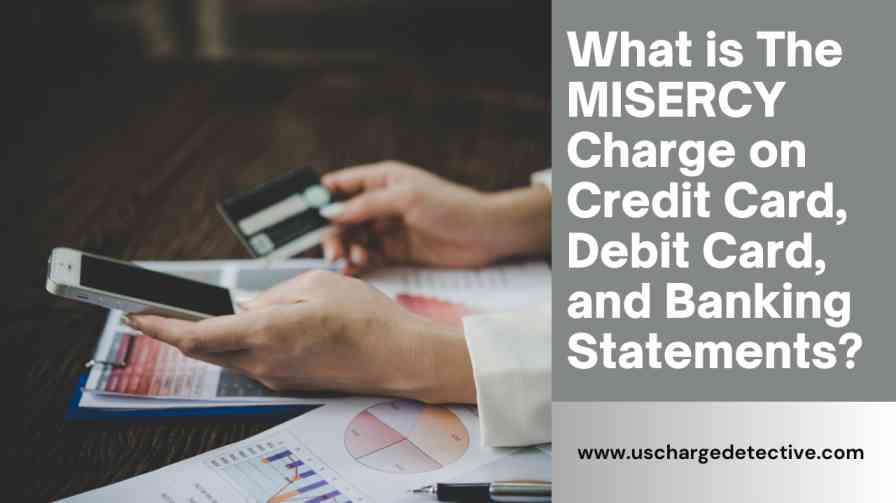These days, credit cards, debit cards, and online banking are indispensable instruments for handling our money. Convenience comes with complexity, though, and occasionally we see odd charges on our bills that baffle us. One such confusing accusation is tagged MISERCY. You are not alone if you have ever seen this on your banking statement and wondered what it is all about. We shall explore in great detail in this essay what the MISERCY charge is, why it shows on your statement, and what actions you could take to resolve it.
MUST READ: What is the CPE/BMC Charge On banking statements?
An Overview of MISERCY Charges
Every one of us has been there, looking over our credit card or monthly bank statement and finding an odd charge. The unexplained MISERCY charge can be particularly worrisome since it usually leaves consumers wondering whether they merely forgot about a purchase or if they have been victims of fraud. Protecting your money and making sure you are not paying for something you shouldn’t be paying for depend on an awareness of these costs.
Clarifying MISERCY: What Does It Mean?
On your credit card, debit card, or bank statement, MISERCY may show as a transaction description. But just what does that mean exactly? Usually, it relates to a particular retailer or service provider who handled a payment made via your account. The merchant’s payment processing system might have utilized a shorthand or acronym for MISERCY.
Consider it as a nickname; the merchant or service provider may choose a different moniker for their transaction processing that would not exactly match the name of the company you know. A neighborhood coffee shop might, for example, handle payments under a separate corporate name you are not immediately familiar with.
Typical Motives for MISERCY Charges
A MISERCY charge may show on your bill for a number of typical reasons:
- Service Subscription: Should you be registered for a subscription service, the fee may show under another name—especially if the business employs a third-party payment processing system.
- Smaller Companies: Smaller companies or those with generic names might use a less obvious descriptor.
- Overseas Transactions: Should you have purchased from a foreign merchant, the charge may be handled under another name.
- Third-party payment systems: Certain businesses manage transactions using outside payment processors under names like MISERCY.
Identifying a Legitimate MISERCY Charge
There are a few actions you can do to find out if an unexpected MISERCY charge is legitimate before spiraling over it:
- Review recent purchases: Review your most recent purchases to find whether any match the amount paid under MISERCY.
- Examine subscriptions: Check if the charge could be connected to any of your active subscriptions.
- Investigate Online: Finding the retailer by a quick web search of the term MISERCY and the charged amount could assist you.
- Speak with the merchant: Should you have any questions, personally contact the business to verify the charge.
Guidelines for Resubmitting a MISERCY Charge
It’s time to fight the MISERCY charge if you have verified that it is illegal or erroneous. Here is how:
- One should compile information: Get all pertinent data including the charge date, charge amount, and any correspondence with the merchant.
- Speak with your credit card company or bank: As soon as you find the illegal charge, let your credit card company or bank know.
- Complete a Dispute Form: Most credit card providers and banks will want you to complete a dispute form starting an inquiry.
- View Your Account: Watch your account for any updates or any illegal charges.
Preventing Unauthorized MISERCY Charges: Strategies
Always preferable to cure is prevention. You can stop illegal MISERCY charges like this:
- Often check your accounts: Review your credit card and bank statements often to find any odd expenditures early on.
- Program Alerts: Many credit card companies and banks let you create alerts for purchases from particular stores or above a given value.
- Apply safe payment techniques: Use safe payment options like PayPal or virtual credit cards wherever you can to provide still another degree of security.
Appreciating the Function of Merchant Descriptors

Your credit card or bank statements show names known as merchant descriptors. They might differ from the name of the company where you made a purchase, exactly. Spotting possible fraud and recognizing lawful transactions depend on an awareness of these descriptors.
A merchant descriptor used by a company you have dealt with could be MISERGY, but given it is not the name you know, it begs questions. Understanding these descriptions can help you to save time and frustration.
How Credit Card Companies and Banks Address MISERCY Problems
Should you contest a MISERCY charge, your credit card or bank will act in many ways:
- One first look: They will first go over your claim and compile transaction specifics.
- Notifying the Merchant: The bank or credit card company will get in touch with the retailer to confirm the charge.
- Temporary Credit: Sometimes they could temporarily credit your account while they look at things.
- Last Decision: Once their research is finished, they will let you know of their choice and act accordingly, such as undoing the charge should it prove to be illegal.
Real-life Illustrations of MISERCY Charges
Let’s examine a few actual cases of MISERCY charges to help you get a better picture:
- Subscription Service of John: In his statement, John found a MISERY charge. After some investigation, he discovered it was connected to his monthly subscription to a streaming service running a third-party payment processing system.
- Sarah’s Coffee Shop Purchase: A MISERCY charge perplexed Sarah; later she found it came from her neighborhood coffee shop, which handled payments under a different corporate name.
The Direction of Banking and the Function of MISERCY
The ways in which transactions are handled change along with financial technology. As companies keep using distinct merchant descriptors and outside payment processors, MISERCY charges may become more widespread. Navigating these developments will depend mostly on keeping informed and alert.
Common Questions Regarding MISERCY Charges
1. Should I ignore a MISERCY charge shown on my statement?
Try first matching the charge to any recent subscriptions or purchases. If you still find it difficult, acquire further information by calling your bank or the retailer.
2. Does a MISERCY accusation point toward fraud?
It is indeed feasible. It may be fraud if you cannot connect the charge to any of your transactions and do not understand its nature. Right away report it to your credit card or bank.
3. How long does it take to settle a dispute on a MISERCY charge?
Though the times vary, most disagreements are settled in 30 to 90 days. Your credit card or bank will keep you informed all through the procedure.
4. Is there any way I may stop MISERCY charges showing up on my bill?
Although you cannot totally stop them, simply utilizing reputable stores and routinely checking your account for strange activity will help to lower the danger.
5. What is MISERCY?
A payment processor most certainly uses MISERCY as a merchant description or abbreviation. It’s a label rather than a precise term that might not line up with the company name you know.
Conclusion
Though it may be perplexing, the MISERCY charge shown on your credit card, debit card, or banking statement does not always call for concern. Understanding what it is, why it looks, and how to handle it will help you guard your money and prevent unwarranted worry. Always be proactive by keeping an eye on your statements and knowing about your purchases.
MUST READ: What is TW&M Digital Charge on my Credit Card and Banking Statements?
